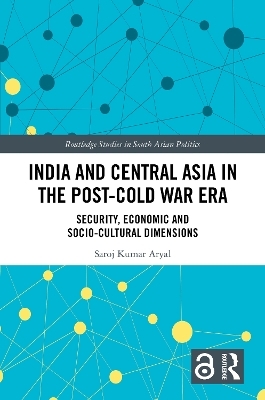
India and Central Asia in the Post-Cold War Era
Routledge (Verlag)
978-1-032-83513-6 (ISBN)
- Noch nicht erschienen (ca. Dezember 2024)
- Versandkostenfrei
- Auch auf Rechnung
- Artikel merken
This book analyses the evolution of India’s foreign policy towards Central Asia after the end of the Cold War.
Focusing on the development of India’s foreign policy towards Central Asia between 1991 and 2020, this book investigates the explanatory and intervening variables of the policy towards the region to identify its goals, assumptions, motivations and instruments. The preliminary assumption is that India’s foreign policy towards Central Asia has evolved after the Cold War from a passive approach to an active participant in Central Asian security, economic and socio-cultural spheres. This is also seen due to the emergence of the five Central Asian countries as independent states, which have a tremendous strategic significance due to their geographical location, huge hydrocarbon reserve and potential economic opportunities. India expanded its policy to the ‘Extended Neighbourhood,’ adding East, Central and West Asia to the existing South Asian neighbourhood. Since then, India has been engaging with the region considering the growing geostrategic and geo-economic significance of the region and using the available foreign policy instruments. This book presents a comprehensive assessment of India’s foreign policy behaviour evolution with proper analysis of the explanatory (external) and intervening (internal) variables that influence India’s behaviours towards the region. It shows that India also aims to be a very influential power in Central Asia.
This book will be an excellent resource for students and researchers of area and global studies, international relations, Asian Politics and South and Central Asia.
Saroj Kumar Aryal is a researcher at the Faculty of Political Science and International Studies, University of Warsaw, Poland. His book, Violence, Power and Politics in South Asia: From Kashmir to Kathmandu, co-authored with Gaurav Bhattarai, is forthcoming with Routledge.
Introduction; Chapter 1: Reconstruction of the Model of Analysis; Chapter 2: Evolution of India’s Foreign Policy after the Cold War; Chapter 3: Security Dimension of India’s Foreign Policy towards Central Asia Region; Chapter 4: Economic Dimension of India's Foreign Policy towards Central Asia Region; Chapter 5: Socio-Cultural Dimension of India’s Foreign Policy towards Central Asia Region; Chapter 6: Dimensions of India’s Foreign Policy towards Central Asia Region after the Cold War; Conclusion: Summary of the Research Results; Annex 1- List of Study Visits; Index
| Erscheint lt. Verlag | 2.12.2024 |
|---|---|
| Reihe/Serie | Routledge Studies in South Asian Politics |
| Zusatzinfo | 23 Tables, black and white; 17 Line drawings, black and white; 17 Illustrations, black and white |
| Verlagsort | London |
| Sprache | englisch |
| Maße | 156 x 234 mm |
| Themenwelt | Naturwissenschaften ► Geowissenschaften ► Geografie / Kartografie |
| Sozialwissenschaften ► Politik / Verwaltung ► Europäische / Internationale Politik | |
| Sozialwissenschaften ► Soziologie ► Spezielle Soziologien | |
| ISBN-10 | 1-032-83513-3 / 1032835133 |
| ISBN-13 | 978-1-032-83513-6 / 9781032835136 |
| Zustand | Neuware |
| Haben Sie eine Frage zum Produkt? |
aus dem Bereich


